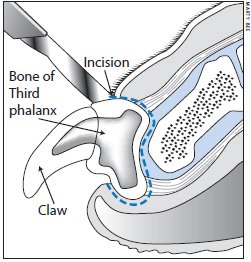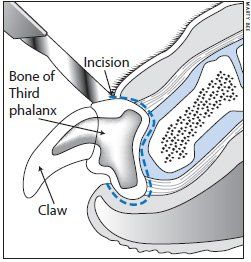[From Tufts January 2012 Issue]
The American Veterinary Medical Association recently produced a five-minute video, available on its website, about the controversial procedure of declawing. Its recommendations for pet owners boil down to this: First, try some of the many non-surgical alternatives to stop cats from scratching your favorite easy chair or carpet. If these don’t work, and it becomes a choice between declawing and surrendering your cat to an animal shelter or, even worse, euthanizing him, consider the surgery.

Here’s what is involved in the procedure: Each of the cat’s claws and the third bone of every toe are removed with a laser, blade or nail trimmers. If the bone is not removed, the claw will eventually grow back. Most often, the procedure involves only the front paws. A laser reduces the risk of bleeding, and some veterinarians believe that it also reduces the amount of pain after surgery. If a laser is used, the feet do not need to be bandaged afterward. Most veterinarians bandage the feet for 12 to 24 hours if a blade or nail trimmers are used.
Aggressive pain management is crucial. The cat receives pain medication before and after surgery, and a local anesthetic may be injected around the wrist area after general anesthesia is induced, explains Colleen E. Currigan, DVM, one of the veterinarians featured in the AVMA video.
Afterward, the cat is monitored in the recovery area and given pain medication for home use. The AVMA recommends that declawed cats live only indoors. They no longer have claws to defend themselves against dogs, raccoons and other predators, and cannot escape by climbing trees.”I never want an owner to feel guilty for having made the decision to declaw,” says Dr. Currigan. “I want them to be informed and for it to be an informed decision.”
BIGSTOCK

Scratching is a normal way of life for cats — they do it to remove husks from their nails, to stretch and to mark territory. Both the scent left during scratching and the visual evidence of damage serve as messages to other cats.
“Having claws is basically part of being a cat,” says Nicholas Dodman, BVMS, director of the animal behavior clinic at Cummings School of Veterinary Medicine at Tufts University. “So to take the claw out of the cat is to sort of remove part of its very being and its reason for being a cat. It’s what cats do — they scratch furniture. Even though I say lighten up, let go of your furniture and your inhibitions, let cats walk on the counter, let them scratch up some things, the fact is that some people aren’t that comfortable with cats scratching anything in the house.”
Dr. Dodman and Dr. Currigan offer a dozen tips for reducing scratching that may be tried before considering declawing surgery:
– Provide many sturdy scratching boards and posts.
Select products that are made of durable material such as wood or corrugated cardboard and that are very stable. If it rocks, the cat won’t like it. If you live with two cats, you need three scratching devices, perhaps of different varieties. Scratching posts should be tall enough for the cat to stretch up to his full height and scratch right at the top.
– Offer the right materials for scratching — from the cat’s viewpoint.
Cats like to leave visual and olfactory marks when they scratch, so they prefer items made of materials that can be shredded. Consider materials such as hemp or sack-cloth that shreds easily over over a base of more durable material. Old, 4-foot-tall stereo speakers with front covers made of foam rubber can work well, as can a piece of bark from the woods. A piece of bark about four inches in diameter can be removed from a log and nailed to a a secure board.
– Place the scratching posts in cat-preferred locations.
Since one major purpose of scratching is to leave a visual mark, do not try to hide a scratching post behind the sofa or in some other out-of-the-way location. Instead, initially put the scratching post in a very obvious, high-traffic area. Move the post an inch or two each day to a location that’s more convenient for you. You can also place a scratching board or post near the cat’s bed. Like us, cats like to stretch when they wake up. Consider another scratching board or post near the litter box.
– Realize that different cats have different scratching preferences.
Some cats will only scratch at horizontal surfaces, or only at certain materials. Learn your cat’s preferences.
– Sprinkle catnip on a scratching post to get your cat to focus on it.
Or, run a favorite toy up the scratching post to lure your cat, then immediately feed a treat — another effective strategy to increase the use of the scratching post, notes Dr. Currigan.
– Protect your prized possessions from being scratched.
For example, put a physical barrier around your favorite chair to prevent your cat from accessing it. You can also prop a cardboard scratcher against the chair so that your cat will sharpen his claws on the scratcher and not the chair. You can also simply shut the door to a particular room to keep its furniture off limits to your cat.
– Spray furniture with scented lemon or orange sprays.
Cats detest citrus smells and will be more likely to avoid items with these scents.
– Apply double-sided tape to areas you don’t want scratched.
Most cats dislike sticky surfaces.
– Trim your cat’s nails every month to six weeks to minimize damage to furniture.
If you do not feel that you can do this, arrange to have your cat’s nails trimmed by a professional pet groomer or a veterinary technician.
– Fit the cat’s nails with soft vinyl nail caps.
Sold under such brand names as Soft Claws and Soft Paws, these vinyl caps can be glued onto a cat’s trimmed nails in the veterinary clinic or at home. Be aware that caps need to be replaced every 4 to 6 weeks.
– Provide safe outdoor access to allow your cat to scratch trees.
A cat fence in the backyard will provide a controlled environment where your cat may claw at trees.
– Adopt a philosophical attitude.
That’s what Dr. Dodman did when his two late cats targeted a satin-covered hardback antique chair and wrecked the covering. “They were happy doing that and I didn’t care. Now that they’ve passed away, I can replace the covering on the the chair,” Dr. Dodman says. “A chair can be repaired, but a cat is a living thing.” Be prepared for some trial and error as you work to identify the strategies that work best for your cat.




